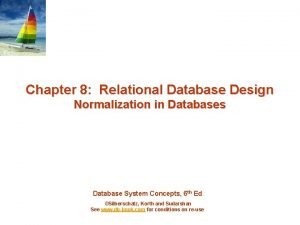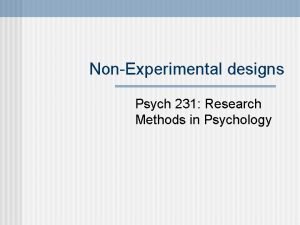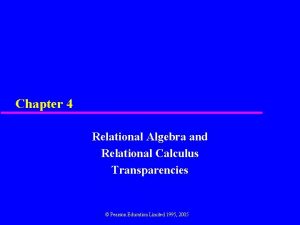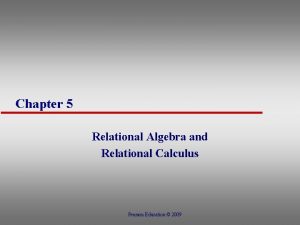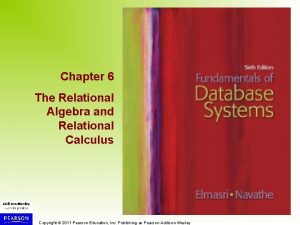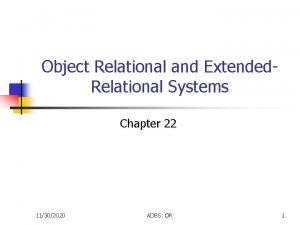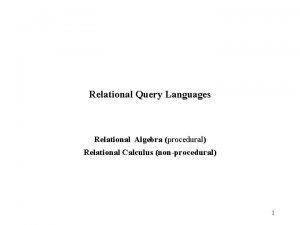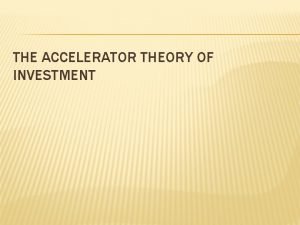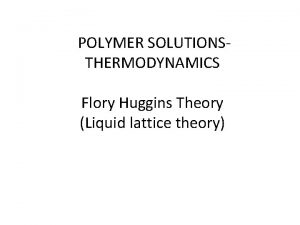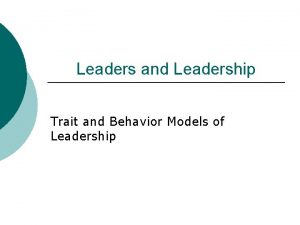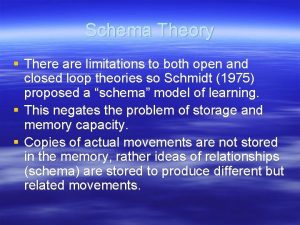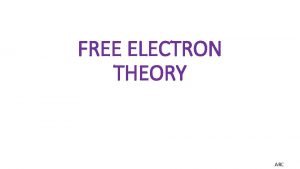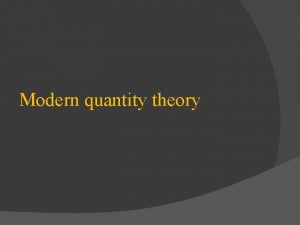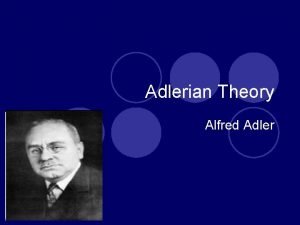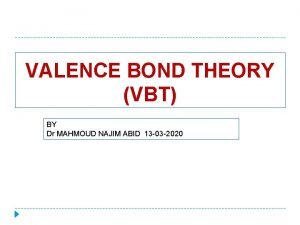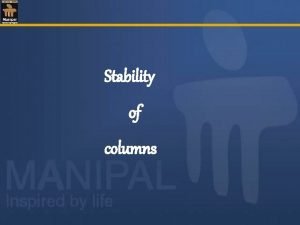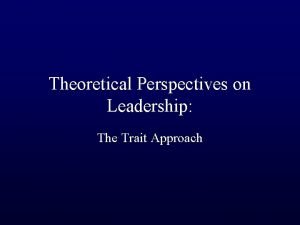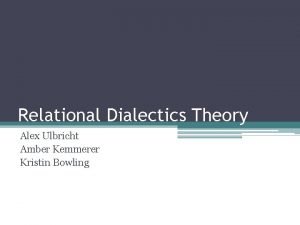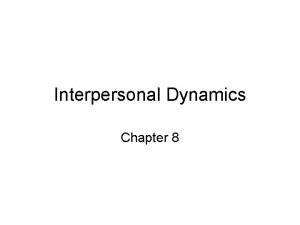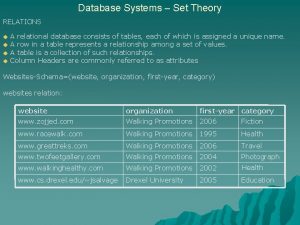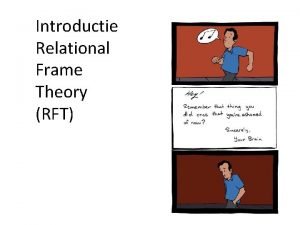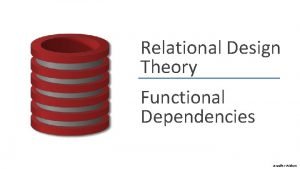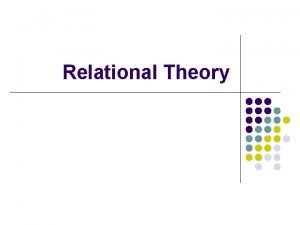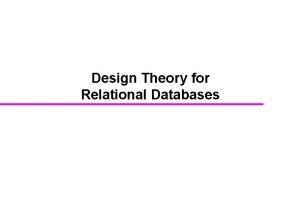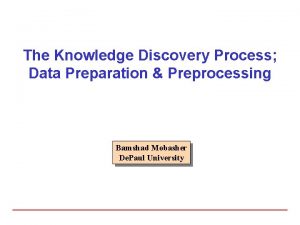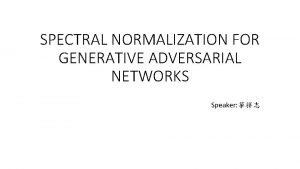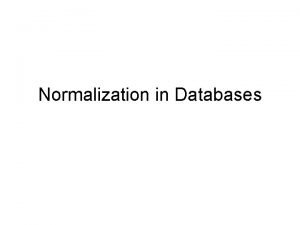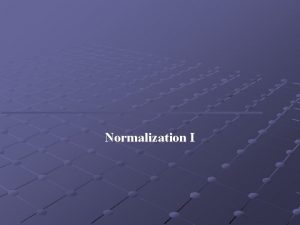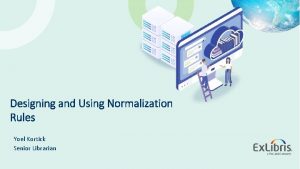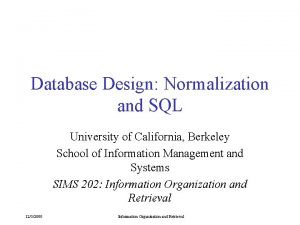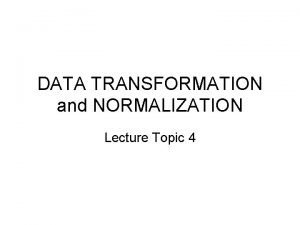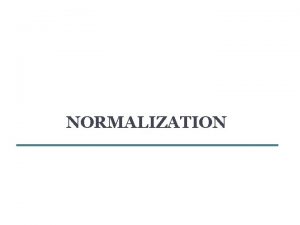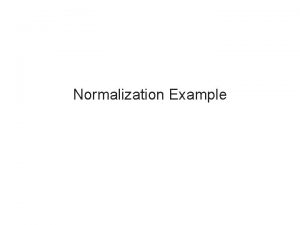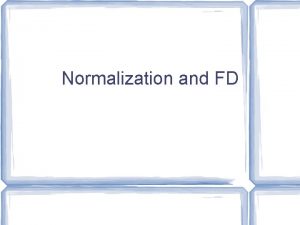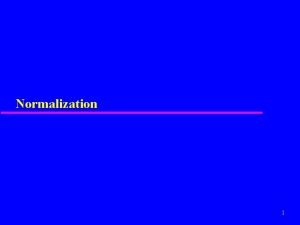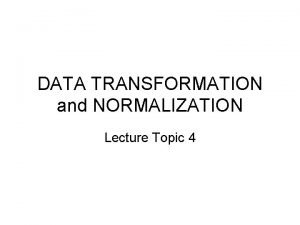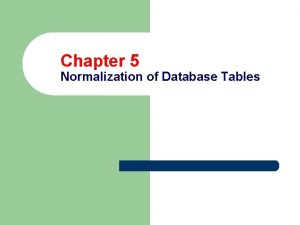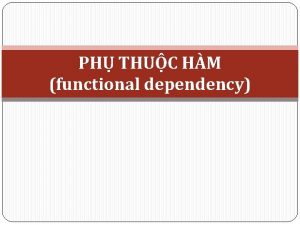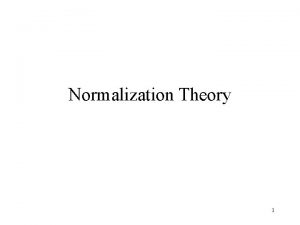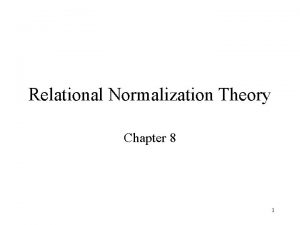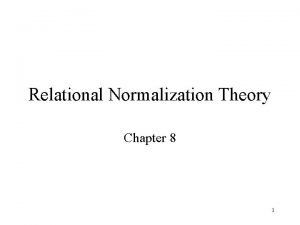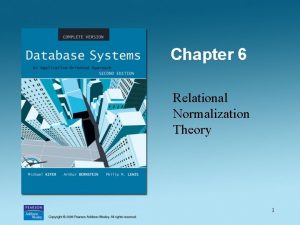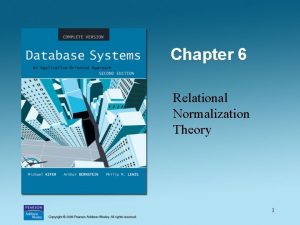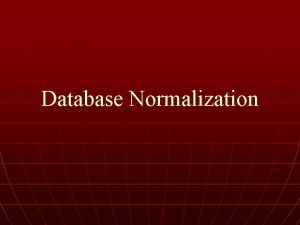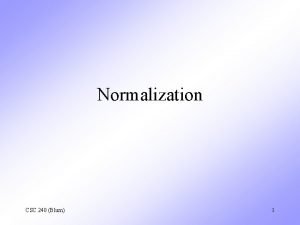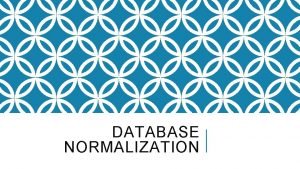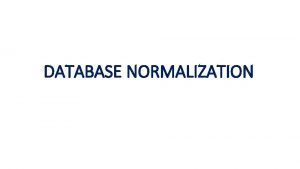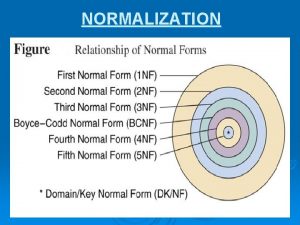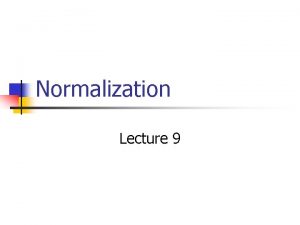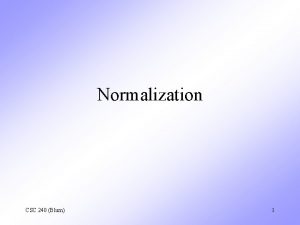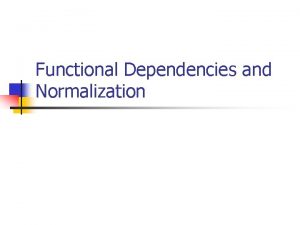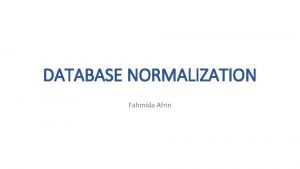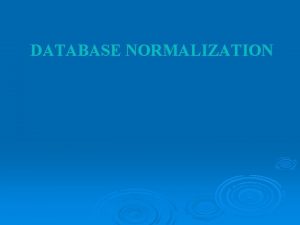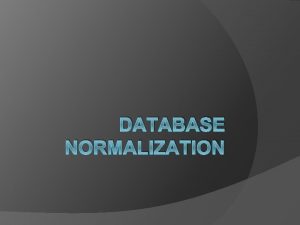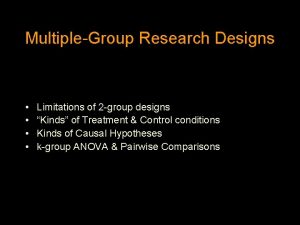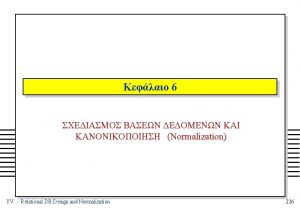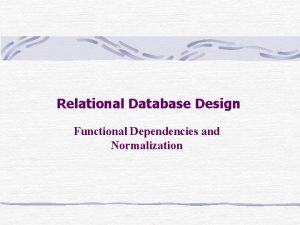Relational Normalization Theory 1 Limitations of ER Designs
















































- Slides: 48

Relational Normalization Theory 1

Limitations of E-R Designs • Provides a set of guidelines, does not result in a unique database schema • Does not provide a way of evaluating alternative schemas • Normalization theory provides a mechanism for analyzing and refining the schema produced by an E-R design 2

Redundancy • Dependencies between attributes cause redundancy – Eg. All addresses in the same town have the same zip code SSN Name Town 1234 Joe Stony Brook 4321 Mary Stony Brook 5454 Tom Stony Brook …………………. Zip 11790 Redundancy 3

Example ER Model SSN Name 1111 Joe Address 123 Main Hobby {biking, hiking} Relational Model SSN Name Address 1111 Joe 123 Main ……………. Hobby biking hiking Redundancy 4

Anomalies • Redundancy leads to anomalies: – Update anomaly: A change in Address must be made in several places – Deletion anomaly: Suppose a person gives up all hobbies. Do we: • Set Hobby attribute to null? No, since Hobby is part of key • Delete the entire row? No, since we lose other information in the row – Insertion anomaly: Hobby value must be supplied for any inserted row since Hobby is part of key 5

Decomposition • Solution: use two relations to store Person information – Person 1 (SSN, Name, Address) – Hobbies (SSN, Hobby) • The decomposition is more general: people with hobbies can now be described • No update anomalies: – Name and address stored once – A hobby can be separately supplied or deleted 6

Normalization Theory • Result of E-R analysis need further refinement • Appropriate decomposition can solve problems • The underlying theory is referred to as normalization theory and is based on functional dependencies (and other kinds, like multi-valued dependencies) dependencies 7

Functional Dependencies • Definition: A functional dependency (FD) on a relation schema R is a constraint X Y, where X and Y are subsets of attributes of R. • An FD X Y is satisfied in an instance r of R if for every pair of tuples, t and s: if t and s agree on all attributes in X then they must agree on all attributes in Y – Key constraint is a special kind of functional dependency: all attributes of relation occur on the right -hand side of the FD: • SSN, Name, Address 8

Functional Dependencies (Examples) • Address Zip. Code – Stony Brook’s ZIP is 11733 • Artist. Name Birth. Year – Picasso was born in 1881 • Autobrand Manufacturer, Engine type – Pontiac is built by General Motors with gasoline engine • Author, Title Publ. Date – Shakespeare’s Hamlet published in 1600 9

Functional Dependency - Example • Brokerage firm allows multiple clients to share an account, but each account is managed from a single office and a client can have no more than one account in an office – Has. Account (Acct. Num, Client. Id, Office. Id) • keys are (Client. Id, Office. Id), (Acct. Num, Client. Id) – Client, Office. Id Acct. Num – Acct. Num Office. Id • Thus, attribute values need not depend only on key values 10

Entailment, Closure, Equivalence • Definition: If F is a set of FDs on schema R and f is another FD on R, then F entails f if every instance r of R that satisfies every FD in F also satisfies f – Ex: F = {A B, B C} and f is A C • If Streetaddr Town and Town Zip then Streetaddr Zip • Definition: The closure of F, denoted F+, is the set of all FDs entailed by F • Definition: F and G are equivalent if F entails G and G entails F 11

Armstrong’s Axioms for FDs • This is the syntactic way of computing/testing the various properties of FDs • Reflexivity: If Y X then X Y (trivial FD) – Name, Address Name • Augmentation: If X Y then X Z YZ – If Town Zip then Town, Name Zip, Name • Transitivity: If X Y and Y Z then X Z 12

Derived inference rules • Union: if X Y and X Z, then X YZ. • Decomposition: if X YZ, then X Y and X Z. • Pseudotransitivity: if X Y and WY Z, then WX Z. • These additional rules are not essential; their soundness can be proved using Armstrong’s Axioms. • Exercise: Prove rules Decomposition and Pseudotransitivity using A. A. 13

Generating + F F AB C A D D E aug union AB BCD AB BD trans decomp AB BCDE AB CDE BCDE Thus, AB BD, AB BCDE, and AB CDE are all elements of F+ 14

Attribute Closure • Calculating attribute closure leads to a more efficient way of checking entailment • The attribute closure of a set of attributes, X, with respect to a set of functional dependencies, F, (denoted X+F) is the set of all attributes, A, such that X A – X +F 1 is not necessarily the same as X +F 2 if F 1 F 2 • Attribute closure and entailment: – Algorithm: Algorithm Given a set of FDs, F, then X Y if and only if X+F Y 15

Example - Computing Attribute Closure X F: AB C A D D E AC B Is AB E entailed by F? Yes Is D C entailed by F? No A AB X F+ {A, D, E} {A, B, C, D, E} (Hence AB is a key) B D {B} {D, E} Result: XF+ allows us to determine FDs of the form X Y entailed by F 16

Computation of Attribute Closure X+F closure : = X; // since X X+F repeat old : = closure; if there is an FD Z V in F such that Z closure and V closure then closure : = closure V until old = closure – If T closure then X T is entailed by F 17

Example: Computation of Attribute Closure Problem: Compute the attribute closure of AB with respect to the set of FDs : AB C (a) Solution: A D (b) D E (c) AC B (d) Initially closure = {AB} Using (a) closure = {ABC} Using (b) closure = {ABCD} Using (c) closure = {ABCDE} 18

Normal Forms • Each normal form is a set of conditions on a schema that guarantees certain properties (relating to redundancy and update anomalies) • First normal form (1 NF) is the same as the definition of relational model (relations = sets of tuples; each tuple = sequence of atomic values) • Second normal form (2 NF) – a research lab accident; has no practical or theoretical value – won’t discuss • The two commonly used normal forms are third normal form (3 NF) and Boyce-Codd normal form (BCNF) 19

BCNF • Definition: A relation schema R is in BCNF if for every FD X Y associated with R either – Y X (i. e. , the FD is trivial) or – X is a superkey of R • Example: Person 1(SSN, Name, Address) Person 1 – The only FD is SSN Name, Address – Since SSN is a key, Person 1 is in BCNF 20

(non) BCNF Examples • Person (SSN, Name, Address, Hobby) – The FD SSN Name, Address does not satisfy requirements of BCNF • since the key is (SSN, Hobby) • Has. Account (Account. Number, Client. Id, Office. Id) – The FD Acct. Num Office. Id does not satisfy BCNF requirements • since keys are (Client. Id, Office. Id) and (Acct. Num, Client. Id) 21

Redundancy • Suppose R has a FD A B. If an instance has 2 rows with same value in A, they must also have same value in B (=> redundancy, if the A-value repeats twice) SSN redundancy SSN Name 1111 Joe Name, Address Hobby 123 Main stamps 123 Main coins • If A is a superkey, there cannot be two rows with same value of A – Hence, BCNF eliminates redundancy 22

Third Normal Form • A relational schema R is in 3 NF if for every FD X Y associated with R either: – Y X (i. e. , the FD is trivial); or – X is a superkey of R; or – Every A Y is part of some key of R • 3 NF is weaker than BCNF (every schema that is in BCNF is also in 3 NF) BCNF conditions 23

3 NF Example • Has. Account (Acct. Num, Client. Id, Office. Id) – Client. Id, Office. Id Acct. Num • OK since LHS contains a key – Acct. Num Office. Id • OK since RHS is part of a key • Has. Account is in 3 NF but it might still contain redundant information due to Acct. Num Office. Id (which is not allowed by BCNF) 24

3 NF Example • Has. Account might store redundant data: Client. Id 1111 2222 3333 Office. Id Stony Brook Acct. Num 28315 3 NF: Office. Id part of key FD: Acct. Num Office. Id redundancy • Decompose to eliminate redundancy: Client. Id Acct. Num 1111 2222 3333 28315 BCNF (only trivial FDs) Office. Id Stony Brook Acct. Num 28315 BCNF: Acct. Num is key FD: Acct. Num Office. Id 25

(Non) 3 NF Example • Person (SSN, Name, Address, Hobby) – (SSN, Hobby) is the only key. – SSN Name violates 3 NF conditions since Name is not part of a key and SSN is not a superkey 26

Decompositions • Goal: Eliminate redundancy by decomposing a relation into several relations in a higher normal form • Decomposition must be lossless: lossless it must be possible to reconstruct the original relation from the relations in the decomposition • We will see why 27

Decomposition • Schema R = (R, F) – R is a set of attributes – F is a set of functional dependencies over R • The decomposition of schema R is a collection of schemas Ri = (Ri, Fi) where – R = i Ri for all i (no new attributes) – Fi is a set of functional dependences involving only attributes of Ri – F entails Fi for all i (no new FDs) • The decomposition of an instance, instance r, of R is a set of relations ri = Ri(r) for all i 28

Example Decomposition Schema (R, F) where R = {SSN, Name, Address, Hobby} F = {SSN Name, Address} can be decomposed into R 1 = {SSN, Name, Address} F 1 = {SSN Name, Address} and R 2 = {SSN, Hobby} F 2 = { } 29

Lossless Schema Decomposition • A decomposition should not lose information • A decomposition (R 1, …, Rn) of a schema, R, is lossless if every valid instance, r, of R can be reconstructed from its components: r = r 1 r 2 …… rn where each ri = Ri(r) 30

Lossy Decomposition The following is always the case (Think why? ): r r 1 r 2 rn . . . But the following is not always true: r r 1 Example: SSN Name 1111 Joe 2222 Alice 3333 Alice r 2 r . . . rn r 1 Address SSN Name 1 Pine 2 Oak 3 Pine 1111 Joe 2222 Alice 3333 Alice r 2 Name Address Joe Alice 1 Pine 2 Oak 3 Pine The tuples (2222, Alice, 3 Pine) and (3333, Alice, 2 Oak) are in the join, but not in the original 31

Lossy Decompositions: What is Actually Lost? • In the previous example, the tuples (2222, Alice, 3 Pine) and (3333, Alice, 2 Oak) were gained, not lost! – Why do we say that the decomposition was lossy? • What was lost is information: – That 2222 lives at 2 Oak: In the decomposition, 2222 can live at either 2 Oak or 3 Pine – That 3333 lives at 3 Pine: In the decomposition, 3333 can live at either 2 Oak or 3 Pine 32

Testing for Losslessness • A (binary) decomposition of R = (R, F) into R 1 = (R 1, F 1) and R 2 = (R 2, F 2) is lossless if and only if : – either the FD • (R 1 R 2 ) R 1 is in F+ – or the FD • (R 1 R 2 ) R 2 is in F+ 33

Example Schema (R, F) where R = {SSN, Name, Address, Hobby} F = {SSN Name, Address} can be decomposed into R 1 = {SSN, Name, Address} F 1 = {SSN Name, Address} and R 2 = {SSN, Hobby} F 2 = { } Since R 1 R 2 = SSN and SSN R 1 the decomposition is lossless 34

Dependency Preservation • Consider a decomposition of R = (R, F) into R 1 = (R 1, F 1) and R 2 = (R 2, F 2) – An FD X Y of F is in Fi iff X Y Ri – An FD, f F may be in neither F 1, nor F 2, nor even (F 1 F 2)+ • Checking that f is true in r 1 or r 2 is (relatively) easy • Checking f in r 1 r 2 is harder – requires a join • Ideally: want to check FDs locally, in r 1 and r 2, and have a guarantee that every f F holds in r 1 r 2 • The decomposition is dependency preserving iff the sets F and F 1 F 2 are equivalent: F+ = (F 1 F 2)+ – Then checking all FDs in F, as r 1 and r 2 are updated, can be done by checking F 1 in r 1 and F 2 in r 2 35

Dependency Preservation • If f is an FD in F, but f is not in F 1 F 2, there are two possibilities: – f (F 1 F 2)+ • If the constraints in F 1 and F 2 are maintained, f will be maintained automatically. – f (F 1 F 2)+ • f can be checked only by first taking the join of r 1 and r 2. This is costly. 36

Example Schema (R, F) where R = {SSN, Name, Address, Hobby} F = {SSN Name, Address} can be decomposed into R 1 = {SSN, Name, Address} F 1 = {SSN Name, Address} and R 2 = {SSN, Hobby} F 2 = { } Since F = F 1 F 2 the decomposition is dependency preserving 37

Example • Schema: R= (ABC; F) , F = {A B, B C, C B} • Decomposition: – (AC, F 1), F 1 = {A C} • Note: A C F, but in F+ – (BC, F 2), F 2 = {B C, C B} • A B (F 1 F 2), but A B (F 1 F 2)+. – So F+ = (F 1 F 2)+ and thus the decompositions is still dependency preserving 38

Example • Has. Account (Account. Number, Client. Id, Office. Id) f 1: Account. Number Office. Id f 2: Client. Id, Office. Id Account. Number • Decomposition: Acct. Office = (Account. Number, Office. Id; {Account. Number Office. Id}) Acct. Client = (Account. Number, Client. Id; {}) • Decomposition is lossless: R 1 R 2= {Account. Number} and Account. Number Office. Id • In BCNF • Not dependency preserving: f 2 (F 1 F 2)+ • Has. Account does not have BCNF decompositions that are both lossless and dependency preserving! (Check, eg, by enumeration) • Hence: BCNF+lossless+dependency preserving decompositions are not always achievable! 39

BCNF Decomposition Algorithm Input: R = (R; F) Decomp : = R while there is S = (S; F’) Decomp and S not in BCNF do Find X Y F’ that violates BCNF // X isn’t a superkey in S Replace S in Decomp with S 1 = (XY; F 1), S 2 = (S - (Y - X); F 2) // F 1 = all FDs of F’ involving only attributes of XY // F 2 = all FDs of F’ involving only attributes of S - (Y - X) end return Decomp 40

Example Given: R = (R; T) where R = ABCDEFGH and T = {ABH C, A DE, BGH F, F ADH, BH GE} step 1: Find a FD that violates BCNF Not ABH C since (ABH)+ includes all attributes (BH is a key) A DE violates BCNF since A is not a superkey (A+ =ADE) step 2: Split R into: R 1 = (ADE, {A DE }) R 2 = (ABCFGH; {ABH C, BGH F, F AH , BH G}) Note 1: R 1 is in BCNF Note 2: Decomposition is lossless since A is a key of R 1. Note 3: FDs F D and BH E are not in T 1 or T 2. But both can be derived from T 1 T 2 (E. g. , F A and A D implies F D) Hence, decomposition is dependency preserving. 41

Example (con’t) Given: R 2 = (ABCFGH; {ABH C, BGH F, F AH, BH G}) step 1: Find a FD that violates BCNF. Not ABH C or BGH F, since BH is a key of R 2 F AH violates BCNF since F is not a superkey (F+ =AH) step 2: Split R 2 into: R 21 = (FAH, {F AH}) R 22 = (BCFG; {}) Note 1: Both R 21 and R 22 are in BCNF. Note 2: The decomposition is lossless (since F is a key of R 21) Note 3: FDs ABH C, BGH F, BH G are not in T 21 or T 22 , and they can’t be derived from T 1 T 22. Hence the decomposition is not dependency-preserving 42

Properties of BCNF Decomposition Algorithm • A BCNF decomposition is not necessarily dependency preserving • But always lossless • BCNF+lossless+dependency preserving is sometimes unachievable (recall Has. Account) Has. Account 43

Exercises 1) Consider the following table. • Give an example of update anomaly, an example of deletion anomaly and an example of insertion anomaly knowing that – A product has many suppliers and can have many other products as a substitute (i. e. a product can be replaced by its substitute). – The purchase price is determined by a supplier for a product, while the sale price is for a given product regardless of the supplier. – The quantity is for a given product, again regardless of the supplier. 44

Solution Update Anomaly: - Changing the quantity of a product implies updating the quantity for as many suppliers and substitutes there is for the product. Deletion Anomaly: - By deleting the only substitute of a product, the whole product entry needs to be removed. Insertion Anomaly: - We can’t add a substitute of a product if we do not know the supplier of the product. 45

Exercises (cont. ) 2) Give a schema of a decomposition that avoids such anomalies. • Solution: Product(Product. ID, Quantity, Sale. Price) Suppliers( Product. ID, Supplier. ID, Purchase. Price) Substitutes( Product. ID, Substitute) 46

Exercises 3) A table ABC has attributes A, B, C and a functional dependency A -> BC. Write an SQL assertion that prevents a violation of this functional dependency. CREATE ASSERTION FD CHECK (1 >= ALL ( SELECT COUNT(DISTINCT *) FROM ABC GROUP BY A ) ) 47

4) Assume we have a relation schema R= (player, salary, team, city). An example relation instance: player salary Jeter 15, 600, 000 Garciaparra 10, 500, 000 team Yankees New Red Sox city York Boston We expect the following functional dependencies to hold: • • player →salary, player → team, team →city Argue that R is currently not in BCNF. Decompose R into BCNF. Argue that the decomposition is lossless-join, and that it preserves dependencies. Find an alternative decomposition of R into BCNF which is still lossless-join, but which not preserve dependencies. (State which dependency it does not preserve. ) Show, by means of an example, that a decomposition into (player, salary, city) and (team, city) is not lossless-join. 48
 Candidate key in database
Candidate key in database Small n design disadvantages
Small n design disadvantages The limited tuple relational calculus equals:
The limited tuple relational calculus equals: Relational calculus
Relational calculus The relational calculus is considered as
The relational calculus is considered as Object relational and extended relational databases
Object relational and extended relational databases Relational calculus is a procedural language
Relational calculus is a procedural language Grounded theory research
Grounded theory research Limitations of accelerator theory of investment
Limitations of accelerator theory of investment Limitations of flory huggins theory
Limitations of flory huggins theory Traits theory of leadership
Traits theory of leadership Hinterland central place theory
Hinterland central place theory Limitation of schema theory
Limitation of schema theory Free electron gas theory resumes
Free electron gas theory resumes Assumptions of quantity theory of money
Assumptions of quantity theory of money Alfred adler teori
Alfred adler teori Limitations of valence bond theory
Limitations of valence bond theory Difference between euler and rankine-gordon formula
Difference between euler and rankine-gordon formula Limitations of absolute advantage theory
Limitations of absolute advantage theory Trait approach leadership
Trait approach leadership Interactional dialectics
Interactional dialectics Interpersonal dynamics worksheet answers
Interpersonal dynamics worksheet answers Set theory database
Set theory database Relational frame theory
Relational frame theory Rft betekenis
Rft betekenis Relational design theory
Relational design theory Relational theory
Relational theory Join test
Join test Normalization and weighting in lca
Normalization and weighting in lca Data characterization
Data characterization Spectral normalization gan
Spectral normalization gan Risk normalization examples
Risk normalization examples Primo ve normalization rules
Primo ve normalization rules Example of unnormalized table in database
Example of unnormalized table in database Objectives of database normalization
Objectives of database normalization Normalization of deviance ppt
Normalization of deviance ppt Normalization rules alma
Normalization rules alma Normalization in sql
Normalization in sql Data transformation by normalization
Data transformation by normalization Database normalization cheat sheet
Database normalization cheat sheet Normalization constant
Normalization constant Purpose of normalization
Purpose of normalization What is normalization in dbms
What is normalization in dbms Purpose of normalization
Purpose of normalization Purpose of normalization
Purpose of normalization Data transformation by normalization
Data transformation by normalization Normalization of database tables
Normalization of database tables Normalization
Normalization Functional dependencies and normalization
Functional dependencies and normalization
